ساختمان اداری ساحل سپهر
شیوه دگردیس (امیرحسین طاهری)
راهیافته به مرحله نیمهنهایی سومین دوره جایزه شایستگی معمار ایرانی (۱۳۹۹)
موقعیت: تهران، ایران
تاریخ: ۱۳۹۳
مساحت: ۱۰۱۶۴ مترمربع
وضعیت: ساختهشده
کارفرما: پژوهشکده توسعه کالبدی، با مشارکت شرکت سپهر صادرات
همکاران طراحی فاز یک: ایمان دانشورنژاد، سعید سرانی، ایمان صدرایی طباطبایی، محمدرضا محبعلی
فاز دو: ایمان دانشورنژاد، بیتا رستمی، ناصر نقدی
مدیر پروژه و کارگاه: علی لعلمحمدی
تاسیسات مکانیکی: امیرحسین امیری
نظارت تاسیسات: امیرحسین امیری، اشکان امیری، درویش
نظارت مقیم: فرزاد مهرفام
اجرا: پژوهشکده توسعه کالبدی
عکس: پرهام تقیاف، آریا رهنمایی، سروش مجیدی
زمینه
پروژه ساحل سپهر، در سال ۱۳۸۵، با برنامهای متفاوت از چیزی که هست، به دفتر ما داده شد. قرار بود دفاتر کوچک، با برنامهای مشخص در پروژه ساماندهی شوند. بیپولی کارفرما و تغییر تدریجی برنامه کاربری، سالها برنامه ساخت را به تعویق انداخت، طوری که بهمن ۱۳۸۹، پروژه با برنامه یک ساختمان اداری، با تیپولوژی دفاتر ۶۰ تا ۱۲۰ مترمربعی و طبقه همکف به صورت تکواحد (بعدا دو واحد) برای استفاده کارفرما، وارد پروسه ساخت شد. از همان ابتدا، بنا بر این بود که طراحی به گونهای باشد که طبقات قابلیت حداکثر تجمیع را داشته باشند و یا حتی امکان استفاده یکپارچه از کل ساختمان فراهم باشد.

مهمترین فاکتوری که پس از بازدید از سایت، به نظر ما آمد، موقعیت خاص زمین، به واسطه همسایگیها بود. ساخت پروژه با برنامه مذکور، تهدیدی برای واحدهای همسایگی مجاور و همچنین خود پروژه ما ایجاد میکرد. زمین ما، حاصل تجمیع حدود ۸ قطعه از بافت پیرامون غربی است و در سمت شرق سایت، گودبرداری حاصل از ساخت پروژه عظیم تجاری ـ اداری وجود داشت که سالها رها شده بود و کوچه ما را بر خلاف برنامه شهری، بنبست کرده بود. به نظرمان آمد که همین موضوع، استراتژی اولیه تودهگذاری در سایت است، طوری که به ساختمان ما، یک دیدگاه فراتر از منافع خود پروژه (شهری) اضافه کند و همچنین با بافت مجاور (هر آنچه که هست) در صلح قرار گیرد. آیا ساختوساز امروزی میتواند رابطهای برد ـ برد ایجاد کند؟
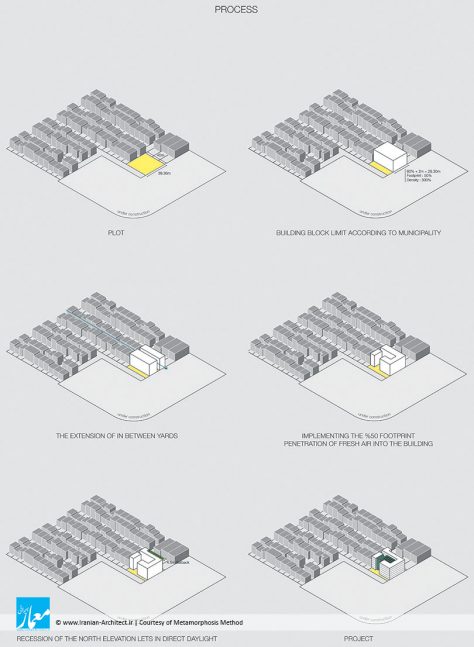
شهرداری
در اولین قدم، با شهرداری وارد مذاکره شدیم تا اجازه امتداد حیاطهای مجاور غربی به داخل پروژه ما را بدهد، یعنی اجازه دهد تا ما از محدوده ۶۰ درصد+۲، ساخت را فراتر ببریم (البته به شرط تامین ۵۰ درصد سطح اشغال که در برنامه بود) و امتداد بدنههای چندلایه غربی را در ساختمان خود بیاوریم، به طوری که نه ما آنها را BLOCK کنیم و نه دیوارههای نامناسب آنها در حیاط ما بیفتد.
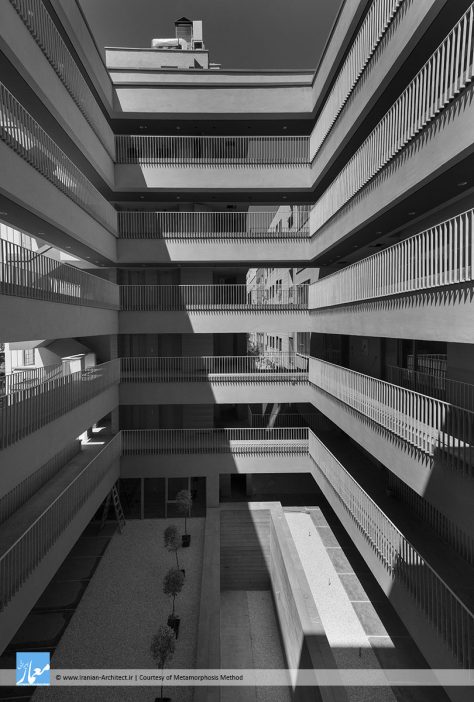
چالش بعدی با شهرداری، استفاده از پتانسیل بنبست شدن کوچه بود، به طوری که بتوان به واسطه ضابطه سایهاندازی ۶۰ درجه، توده شرقی را جابهجا کرد و در نتیجه بنبست تعریف شود، حیاط مرکزی بزرگی به دست آوریم و ساختمان را از حالت دوبعدی خارج کنیم. حالا مابهالتفاوت سطح اشغال و محدوده ساخت، به ما این اجازه را میداد که برشی در توده ایجاد کنیم که نور، هوا و منظر به اعماق پروژه نفوذ کند و ریتم مناسبی در بدنه شهری ایجاد شود.
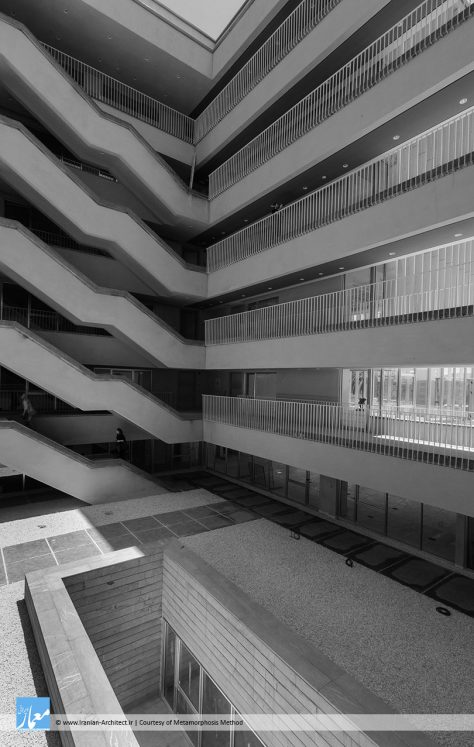
خواص
نتیجه تودهگذاری فوق، تولید واحدهای دو طرف نور ـ منظر، با امکان کوران طبیعی برای همگی آنها بود. سیرکولاسیون پروژه را با ریسک، به صورت هوا ـ باز طراحی کردیم، با فاصله کمی از بدنه که تعلیق آن، به ما یادآوری کند که در حال گذر از فضای بینابینی هستیم. همین راهروها، مسیرهای تاسیساتی ما را نیز سازماندهی کرد. در حین گذر از آنها، پرسپکتیوهای کشفنشدهای از تهران، مثل کریدور سبز همسایگی غربی قاب میشدند. بدنهای غربی به دست آوردیم که انتظار دیدن آن، در این پرسپکتیو از شهر وجود ندارد یا حداقل سالهاست از بین رفته است. با یک عقبنشینی ۴ متری از شمال، امکان نورگیری مستقیم برای بلوک خود فراهم نمودیم و منظر همسایگان شمالی را نیز سطحی فعال کردیم. بعد از ساختهشدن همسایه تجاری ـ اداری شرقی، ساختمان ما رو به درون دارد و کمترین هزینه را از همسایگی با آن میپردازد.
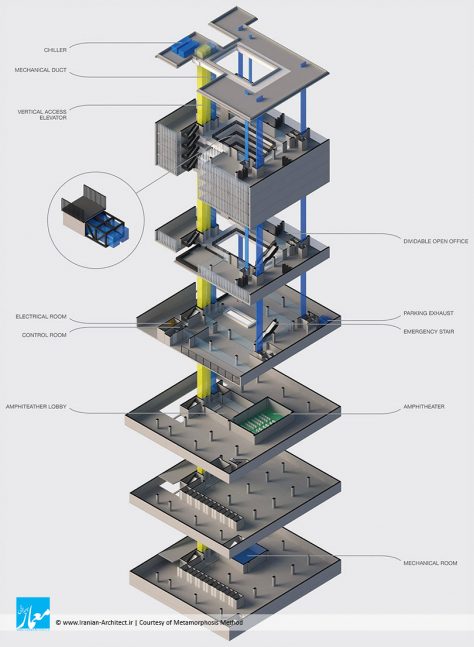
اقتصاد
بحران اقتصادی، درست در مقطعی از پروژه شروع شد که اسکلت ساختمان رو به اتمام بود و استخوان پروژه درآمده بود و به نظر میآمد کار خودمان را کردهایم. در نتیجه، پالت متریال تحت تاثیر قرار گرفت و استقبال کردیم: کنیتکس برای بخشهایی از نما، لوور سفید با ورق کامپوزیت، موزائیک درجا برای کفسازی مشاعات، نرده با پروفیل، نگهداشتن بخش زیادی از استراکچر بتنی که قرار نبود اکسپوز باشد (با کمی مرمت و رتوش) و هیچ متریال غیرایرانی در پروژه استفاده نشد. همینها، به نظر ما تبدیل به ویژگیها و بعضا جذابیتهای پروژه شدند و ساختمان، متری ۱.۲۰۰.۰۰۰ تومان تمام شد.
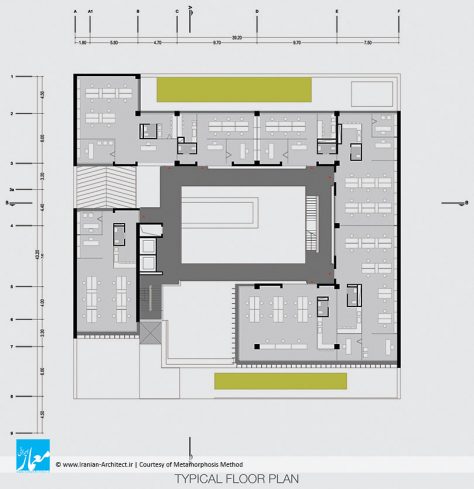
بازار
اواخر پروژه تصمیم بر آن شد که برای فروش یکپارچه اقدام شود. نگرانی ما در تقابل با بازار مصالحمحور و آگهیخور شکل گرفت، اما در عمل، انگار ایدههای ما مورد استقبال واقع شد، انگار هنوز بقایای لذتبردن از فضای باز، مشاعات، نور و هوا وجود دارد. ساختمان نیز با قیمت روز و به صورت یکپارچه فروخته شد. ایدههای ما تبدیل به بدیهیات شده بودند، انگار راهحل دیگری وجود نداشت؛ برخوردهای به ظاهر آرتیستیک ما محو شدند، هیچکس آنها را نمیدید؛ پروژه تخت شد.
Sahel-e-Sepehr Office Building
Metamorphosis Method (Amirhossein Taheri)
Semi-Finalist of Iranian Architect Merit Award 2020
Location: Tehran, Iran
Date: 2014
Area: 10,164 sqm
Status: Completed
Client: Asia Physical Development Consulting Engineers, in Association with Sepehr-e-Saderat Co.
Design: Amirhossein Taheri
Design Team (Phase 1): Iman Daneshvarnejad, Saeed Sarani, Iman Sadraei Tabatabaei, Mohamadreza Mohebali
Design Team (Phase 2): Iman Daneshvarnejad, , Bita Rostami, Naser Naghdi
Supervision: Khashayar Bakhtiari, Zahra Khodabakhsh, Amirhossein Taheri, with thanks to Kaveh Kerdegari
Workshop & Project Manager: Ali Lal Mohammadi
Structure & Supervision: Arya Daneshvar – Hendeseh Mehvar Engineering Co.
Mechanical Consultant: Amirhossein Amiri
Electrical Consultant: Ahmadreza Shirzad
Mechanical Supervision: Amirhossein Amiri, Ashkan Amiri, Darvish
Resident Supervision: Farzad Mehrfam
Construction: Asia Physical Development Consulting Engineers
Presentation: Shafagh Javidi, Irsa Khaleghi, Aria Rahnemaei, Shiva Shirazi
Photo: Parham Taghioff, Aria Rahnemaei, Soroush Majidi
Background
We started the project in 2006, with a brief for small offices with distinct programs. The finances of the client took a turn and so did the brief which led to years of delay, such that the project was re-initiated in 2010 and proceeded into construction phase with a different program; an office building comprising of offices between 60 sqm and 120 sqm, and a single unit ground floor open space office that turned into a double unit later on in the project, for the client’s use. Another aspect was that the building be designed so that units could be combined for single usage allowing the whole building to be used by a single organization, if need be.
The most prominent factor that caught our attention upon our first site visit was the site position in relation to neighboring western lots and a large construction site to the east. Our lot was the size of 8 of the regular western lots combined and a building going up, according to zoning regulations would have been a threat to those neighboring buildings as well as to our project.
Zoning
Our first measure was to negotiate with the municipality, in order to extended the empty space of the back and front yards of the adjacent eastern lots into the our project, so that we would not be blocking the urban corridor created by those yards or have the protruding lip of the adjacent building, in our yard. We negotiated to be permitted to exceed the 60%+2m building limit, while still constraining the footprint of the building to the initial 50%.
Another challenge that we took on with the Municipality was to take advantage of the road being a cul-de-sac and therefore extending out in the dead end side which resulted in a central yard. The combination of these two strategies created new depth that brought in light, air, and made a project that respected its context.
Qualities
With a four meter recess on the north side, we have maintained for each unit light and air and views from two sides and also created an active façade facing our northern neighbors. The project’s circulation is open-air and suspended, with a gap from the main body only connecting at destination points, reinserting itself as an in-between space that opens up a new perspective of the city to us. These corridors have also determined the mechanical and utility installation routes.
Economy
The economical recession that followed the heavy sanctioning of Iran hit the project, at the stage that the building frame had gone up and had direct effects on our material pallet choice. However, it seemed to us that our spatial strategies had already shaped the building, therefore we welcomed this new challenge: Kenitex, and white composite louvers, for the Façade, cast in place mosaic for communal floors, steel profiles for railing, exposing the concert structure although initialing not intended, all materials used in the project were made in Iran and these constraints somehow became characteristics of the project. Ultimately, the building construction came to a total of $400 per square meter, a figure beating minimum rates even in Iran.
Market
Towards the end of construction, it turned out that the client was to sell the building as a whole. In the current Iranian climate of luxury oriented taste in architecture, we were apprehensive about the market response, but the spatial qualities of the building proved to be convincing and our apprehensions soon faded. Our ideas were read as obvious and integral our artistic intervention could not be spotted the projected was uniform; flattened.

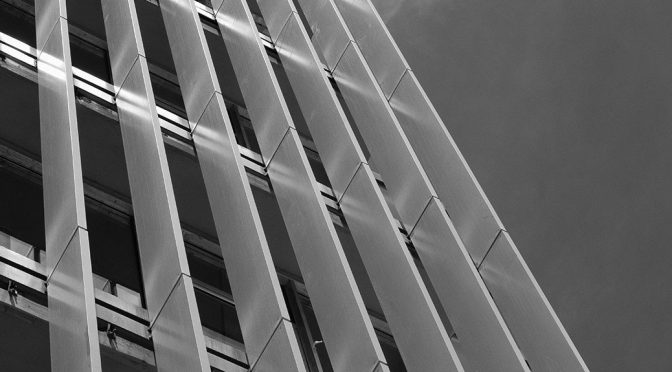
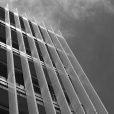
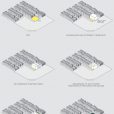
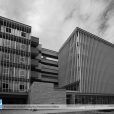
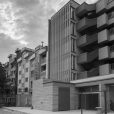
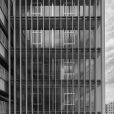
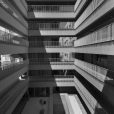
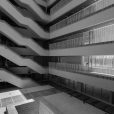
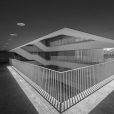
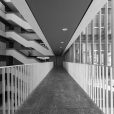
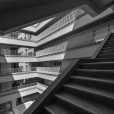
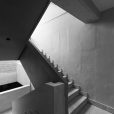
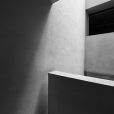
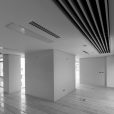
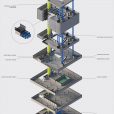
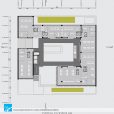
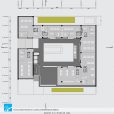
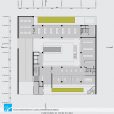
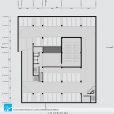
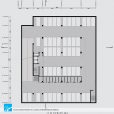
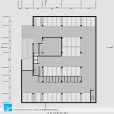
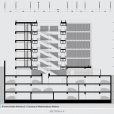
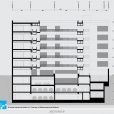
دستت درد نکنه
قشنگ گفتی
.
.
.
پروژه تخت شد……